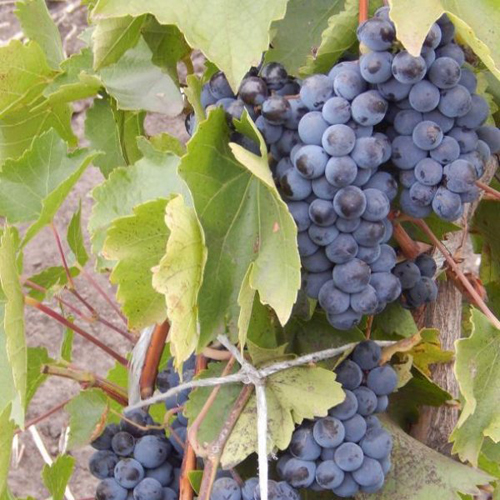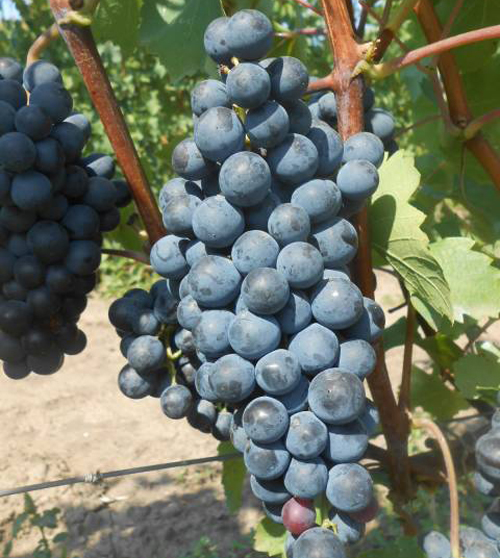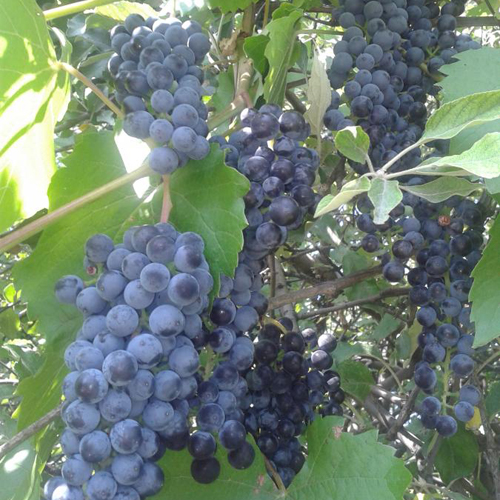Levokumsky grape variety
Levokumsky is a highly resistant technical variety of dark-colored grapes of national selection, widespread in the south of our country. Originally appeared in the region of the same name of the Stavropol Territory, as it is assumed, as a result of spontaneous hybridization with the participation of American species of "sun berry". Subsequently, the new hybrid was noticed by the locals and spread first within the region, and then throughout the region, which has been famous for its winemaking traditions for hundreds of years. Since 2000, our hero has been officially included in the State Register of Breeding Achievements of the Russian Federation and approved for industrial use throughout the North Caucasus region.

The variety is distinguished by its high resistance to the main fungal diseases, excellent frost resistance and very abundant yield. Thanks to these qualities, it is not only cultivated in industrial plantings in its homeland, but also widely distributed among amateurs far beyond the traditional growing area. It easily acclimatizes in the middle zone of the country and even in Siberia, and in many places it is one of the few varieties of grapes that can grow without shelter for the winter.
Agrobiological characteristics
Levokumsky bushes are characterized by high vigor. Leaves are medium in size, somewhat stretched in width, consist, as a rule, of three lobes, while weakly dissected. The upper side of the leaf is shiny, light green, no pubescence on the lower side. The lateral notches are shallow, most often in the form of an inclined angle. The petiolate notch is open, lancet, or vaulted with a flat or pointed bottom. Petioles are long, graceful, pale green with a slight hint of anthocyanin tones in color. The denticles along the edge of the leaf blade are low, transitional to dome-shaped. The inflorescences are bisexual, fully pollinated with their own pollen, and form a knocked down bunch without signs of pea grapes. Grapes are also not prone to shedding flowers and ovaries. Ripening of the vine is good, on average, this figure ranges from 80 to 90%. After ripening, annual shoots turn brown.
Bunches of sizes usual for technical varieties, their average weight is 100-190 grams, cylindrical conical in shape, medium density, or dense. The comb is short, greenish in color. The berries are medium, round, black with a bluish prune bloom on the surface. The mass of 100 grapes is 140-150 grams. The pulp is juicy, neutral in taste and aroma, without pronounced varietal characteristics. Freshly squeezed pink juice, its yield exceeds 70% of the total weight of the bunches. Sugar accumulation is high 20-22 g / 100 cubic meters. cm, the titratable acidity at the time of collection is in the range of 5-6 g / cubic dm. The seeds in the berries are small, their number does not exceed 2-3 pieces.
The grape harvest is intended mainly for the production of high quality red table and dessert wines. Levokumsky has all the prerequisites for this. The wine material made from it is distinguished by its fullness of taste, soft velvety, elegant ruby color. In a magnificent bouquet of drinks, unobtrusive fruity tones can be traced from it. At the same time, the wines meet the highest requirements for the composition of phenolic substances and organic acids. They ripen fairly quickly and are ready to be consumed at a young age, although they may slightly improve their characteristics upon aging. The tasting characteristics of dry table drinks are estimated at an average of 7.5 points, dessert ones - at 8.1 points. Wine materials are often used not in their pure form, but are blended with other varieties, as a result of which they mutually enrich each other's taste and aroma, presenting in a new, completely unexpected light.In addition to alcoholic beverages, this grape is also used to make an excellent juice, which is also distinguished by its excellent taste and richness of color. Grown in private plots, it is quite suitable for home canning.

The growing season lasts 130-140 days from the day the buds bloom in the spring, until the ready to harvest for the production of dry wines. In the Lower Don region, this moment usually falls on the end of August, which makes it possible to classify Levokumsky as a mid-season. In the case of plans for the production of dessert drinks, the grape harvest is shifted a couple of weeks later to allow the plants to accumulate more sugar in the berries. The minimum required number of active temperatures is 2750-2850 ° C, and this circumstance makes it possible to successfully cultivate the variety throughout the Central Black Earth region of the country, in the Lower Volga region and even in those regions of Siberia where it has enough heat for full ripening of the crop. At the same time, in a significant number of non-traditional areas for viticulture, our hero can be cultivated without shelter for the winter, thanks to its exceptional frost resistance, assessed during the state variety test at -35 ° С.
The productivity of Levokumsky is amazing for a technical variety with a medium-sized bunch. In industrial plantations, up to 225 centners of grapes are harvested from one hectare of the area occupied by this variety, and even the average yield of 150 centners / ha is admirable. Such results turned out to be possible due to the high percentage of fruitfulness of shoots, as well as a significant number of clusters laid on them. On average, its fruiting coefficient reaches 1.9. Mature vigorous bushes with a good supply of perennial wood are capable of "pulling" all the clusters growing on the vine to sufficient conditions. The variety is not prone to crop overload and therefore only needs to be normalized with eyes during spring pruning and shoots when carrying out green operations in a growing vineyard.
After the onset of the initial stage of ripening, at which the grape harvest is ready for processing into dry wine, the bunches can be left hanging on the vine for later use in the preparation of dessert drinks. However, at the same time, one must take into account the risk of berry cracking in the event of the onset of prolonged autumn rains, as well as damage to the variety by wasps and birds that are not averse to eating sweet grapes, especially since the thin skin is not a significant obstacle to this. If initially the goal is to obtain the maximum yield in terms of sugar accumulation, then it is worth considering measures to prevent these negative phenomena in advance.
Agrotechnical features
Growing Levokumsky will not be difficult even for a novice winegrower. It has very few requirements for cultivation technology, and therefore it is considered one of the most unpretentious varieties.

Planting should be carried out on soils with an alkaline or neutral reaction. Sour soil must first be prepared for growing grapes on it by liming, gypsum, or another way to reduce acidity. Not suitable for grapes and salt licks, which also need chemical reclamation. Vineyard placement should take into account the thermophilicity of the variety. In those areas where there is a risk of insufficient ripening of the crop, the bushes are planted in the upper part of the slopes of the southern exposure, or in a wall culture, protected from cold northern winds. With this approach, the total amount of heat received by plants during the growing season increases, and the frost-free period, in comparison with the lower part of the slope, can differ in duration by 10-15 days. Adequate moisture provision is preferable, however, excessively damp, wetlands, as well as areas with a close location of groundwater, will definitely not fit a vineyard.There are no high requirements for soil fertility, but at the same time, high productivity also presupposes a significant need for nutrients, and therefore Levokumsky responds positively to fertilization and feeding with macro- and microelements.
The variety is characterized by tolerance to the root phylloxera, due to which, on light-textured soils, it can be planted with own-rooted seedlings, even in regions infected with this soil pest. Rooting of grape cuttings is easy, so reproduction does not pose any particular problems. At the same time, the affinity with common rootstocks is not bad in the variety, however, it is advisable to contact grafted seedlings only in the case of heavy loamy or clayey soil in an area in which phylloxera is especially harmful. The landing pattern can be different. They also practice planting with a large feeding area for bushes - up to 5-6 square meters. meters, and the relative thickening of plantations with an indicator of 4-4.5 sq. meters per plant. At the same time, the harvest is obtained comparable in weight, however, its quality, according to the studies carried out, in the second case will be higher due to a significantly lower load on the bush.
Due to its excellent frost resistance, Levokumsky in the European part of the country can be cultivated almost everywhere on a high trunk without shelter. Such formation, especially if it is associated with free placement of annual growth, allows the variety to demonstrate its best capabilities. And only in the most northern, and therefore frost-dangerous regions, as well as in the harsh climatic conditions of Siberia, grapes will need shelter for the winter. In this case, it is necessary to form plants according to a fan multi-arm scheme, or according to the type of an inclined cordon. This will make it easy to remove the vine from the trellis in the fall and return it back in the spring. As insulation, ordinary digging into the ground will be enough, and in regions with a consistently high snow cover, even simple laying of the aboveground part of the bush on the soil surface.
Spring pruning is carried out in accordance with the planting density of the vines in the vineyard. In sparse areas, they give a high load of up to 40-50 eyes, and on thickened ones, a slightly lower one, 25-30. Fruit arrows shorten strongly, leaving only 4-5 buds on each of them. This is due to the excellent fertility of plants in general, and the lower eyes on the shoots in particular. In the course of the debris, a few sterile and weak vines are removed in such a way that no more than 4-5 strong fruitful shoots remain for each square meter of feeding area. It is not required to thin out the inflorescences and bunches of grapes.
Treatments of a highly resistant Stavropol variety against fungal diseases are required in isolated cases. Levokumsky shows excellent resistance to mildew and gray rot, as well as tolerance to powdery mildew. Thanks to this, the crop harvested from it can be considered environmentally friendly, because plants during the growing season are exposed to a minimum fungicidal load.








